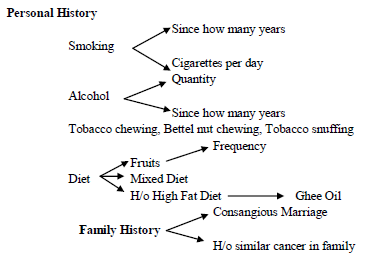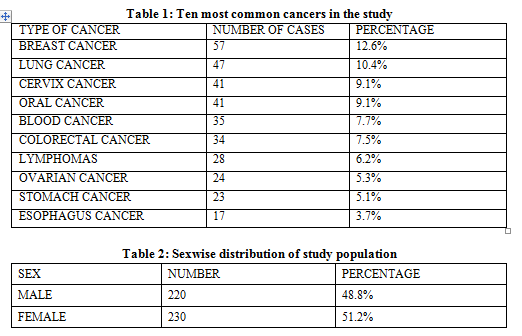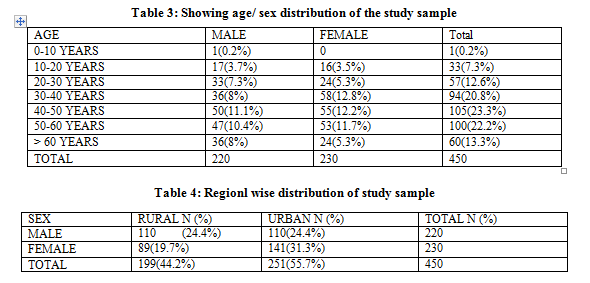IJCRR - 5(23), December, 2013
Pages: 37-43
Date of Publication: 16-Dec-2013
Print Article
Download XML Download PDF
THE INCIDENCE OF COMMON CANCERS IN SOUTH INDIAN REGION - A HOSPITAL BASED CROSS SECTIONAL STUDY - RESEARCH ARTICLE
Author: Raja Sekhar Katikireddi, Siva Nageswara Rao Sundara Setty
Category: Healthcare
Abstract:Objectives: To study the commonest cancers encountered in both male and female sexes in the regional population of Andhra Pradesh in south Indian region. Methods: The study was conducted on total number of 450 patients, who were admitted in Mehdi Nawaz Jung (MNJ) government central cancer hospital, Hyderabad, Andhra Pradesh after histologically confirmed various cancers. Results: the study revealed that Breast cancer (57 cases, 12.6%), Lung cancer (47 cases, 10.4%), Cervical cancer (41 cases, 9.1%), Oral cancer (41 cases, 9.1%), (264 cases, 58.8%) constitute remaining cancers. Males constitute 48. 8% (220 cases) out of 450 cases and Females constitute 51.2% (230 cases) out of of (450 cases). Age and sex distribution revealed maximum number of cancer patients were present between 40 to 50 years (23.3%). Males, majority of cases are present in 40-50 years age group (11.1%) and females majority of cases are seen in 30-40 year age group (12.8%). Distribution of study sample revealed 55.7% cancer cases (251 patients) residing in urban areas and 44.2% cases (199 patients) were found in rural areas and following data discussed in results. Conclusion: Cancer is projected to become a leading cause of death worldwide in low and middle income countries. This will have the impact of high cancer incidence and death rates more sharply than developed countries.
Keywords: Cancer, Brest cancer, Lung cancer, Oral cancer
Full Text:
INTRODUCTION
Cancer is a disease, in which abnormal cells proliferate rapidly without control and are able to occupy other tissues. The abnormal Cancer cells can spread to other parts of the body through various routes. According to the world cancer report, global cancer rates could increase by 50% by the year 2020, this increase can be attributed to increased life expectancy in highly populated countries like China and India.
According to the new edition of the World Cancer Report (WCR 2008), given by the International Agency for Research on Cancers (IARC), the burden of cancer doubled globally between 1975 and 2000. It is estimated that it will double again by 2020 and nearly triple by 2030.The report estimates that there were 12 million new cancers diagnosed worldwide in 2009 and more than seven million people will die of this disease. The projected numbers for the year 2030 are 20-30 million new diagnoses and 13-17 million deaths.
MATERIALS AND METHODS
The present study is hospital based cross sectional study, which conducted on 450 cancer patients, histologically proved as various cancers, who were admitted in a government central cancer hospital. Out of these 220 were male and 230 were female.

H/o Treatment: Previous Hormone Therapy, Previous Radiation Therapy, Drug Overdose
Menstrual History: Age at Menarche, Menstruation Cycle, Duration, Flow, Pain
Obstetric History: Marriage age, No. of children, Mode of delivery,
H/o Abortion/SBS/Premature Labour, Completed Family: Yes/No
General physical examination: Weight, Height, Built, Nourishment, Anaemia, Cyanosis, Clubbing,, Lymphadenopathy, Pedal Oedema, Jaundice, Alopecia
Systemic Examination, Provisional Diagnosis, Investigations, Final Diagnosis, Grade/Stage
RESULTS
Out of 450 cancer patients studied, the most common cancer, over all in the study is Breast cancer(57 cases,12.6%).It is followed by Lung cancer(47 cases,10.4%). It is followed by cervical cancer (41 cases, 9.1%), Oral cancer (41 cases, 9.1%), the remaining (264 cases, 58.8%) constitute other cancers (TABLE: 01). Males constitute 48.8% (220 cases) of total cancer study population (450 cases). Females constitute 51.2% (230 cases) of total cancer study population. (450 cases) (TABLE: 02).
The age / sex distribution revealed maximum number of cancer patients is present between 40 to 50 years (23.3%). Very few patients are present between 0-10 years age group (0.2% 1 case only). In males, majority of cases are present in 40-50 years age group (11.1%), followed by 50-60 year age group (10.4%), 30-40 year age group (8%). While there was no female case in the age group 0-10 years, there was one male in this group.
Females majority of cases are seen in 30-40 year age group (12.8%) followed by 40-50 year age group (12.2%), 50-60 year age group (11.7%). 13.3% (60 patients) of total study group are above 60 years age group (TABLE: 03).
Distribution of study sample revealed 55.7% cancer cases (251 patients) residing in urban areas and 44.2% cases (199 patients) were found in rural areas. Majority of females patients (141 patients, 31.3%) are in urban areas. Males are equally distributed in urban and rural areas (24.4% of total population in each area) (TABLE: 04). Out of a total of 450 cases studied, respiratory cancers (10%, 45 cases) are more common in urban areas. followed by GIT(Gastro Intestinal Tract ) cancer (38 cases,8.4%), breast cancer (38 cases,8.4%), cervix cancer (25 cases,5.5%), oral cancer (25 cases,5.5%) in the urban areas. In the rural areas, GIT cancers (10.6%, 48 cases) are more common followed by breast cancer (19 cases, 4.2%), blood cancer (17 cases, 3.7%). The least number of cancer cases seen in both urban areas and rural areas is with testicular cancer. 1.3% or 6cases in urban and 0.8% or 4 cases in rural areas) (TABLE: 05).
The colorectal cancer has highest incidence of positive family history (23.5%, 8 cases) in the study population. It is followed by ovarian cancer (16.6%, 4 cases), carcinoma breast (6.5%, 4 cases), carcinoma cervix (2.3%, 1 case) in the total study population. Out of total 450 cancer patients studied, 17 cases (3.7%) were found to have positive family history. Remaining 433 patients (96.2%) of the total study population were found to be family history negative (TABLE: 06).
Total of 450 cases, the majority of cancers are present in organs related to reproductive system (94 cases, 20.8%).It included female reproductive system (16.8%, 76 cases) and male reproductive system (4%, 18 cases). It is followed by cancers of gastro intestinal system (86 cases, 19%), connective tissue cancers (81 cases, 18%), respiratory system cancers (61 cases, 13.5%). The least number of cases are seen in endocrine system cancers (1.5%, 7 cases) in males, majority of cases belong to gastro intestinal system followed by, respiratory system. In females majority of cases belong to female reproductive system followed by, gastro intestinal system. In males least number of cases was seen in endocrine system cancers. (2 cases, 0.4%) In females least number of cases are seen in central nervous system cancers (4 cases, 0.8%) .
Out of a total of 230 female cases studied, it was found that breast cancer is the most common cancer in the females (24.7%, 57 cases). It is followed by cervical cancer (17.8%, 41 cases). It is followed by ovarian cancer(24 cases,10.4%), blood cancer(22 cases,9.5%), colorectal cancer(12 cases,5.1%), endometrial cancer(10 cases,4.3%), oral cancer(9 cases,3.9%). Least number of cases are seen in Edwings sarcoma (0.4%, 1 case) and invasive Hydatiform mole (1 case, 0.4%). Highest percentage of female cancer patients is present in labourers (44.7%, 103 cases) It is followed by house wives (70 cases, 30.4%), employees (40 cases, 17.3%). The least percentage of cancer is present in students (7.3 %, 17 cases) the term labourer included agricultural, constructional and domestic workers. Out of a total of 220 male patients, highest percentage of cancer cases are present in Manual labourers (33.1%, 73 cases), followed by semiskilled workers (23.1%,51 cases) . The least percentage of cancer is present in students (8.6%, 19 cases).
Out of a total of 450 cases studied, there were 98 cases of carcinoma cervix/breast obtained. History of menarche was taken in all. It was seen that 52women (53%) had attained menarche between 10-12 years and 33 women (33.6%) had attained menarche between 12-14 years. A total of 85 women (86.6%) had attained menarche between 10-14 years.
Out of a total of 450 cases studied, there were 57 cases of carcinoma breast. History of lactation was taken. It was found that 82.4% (47 cases) of women with breast cancer have breast fed their children. A percentage of17.6% of carcinoma
breast patients did not have a positive lactational history.
Out of a total of 220 male cases studied, it was found that Lung cancer is the most common cancer in males in our study (17.7%, 39 cases). It is followed by oral cancer(32 cases,14.5%), colorectal cancer (22 cases,10%), lymphoma(20 cases,9%), stomach cancer (16cases,7.2%), esophagus cancer (13cases,5.9%), blood cancer (13cases,5.9%), testicular cancer (10 cases ,4.5%). The least number of cases are seen in duodenal cancer (0.4%, 1 case), (54 cases 24.9%) constitute the remaining cancers. Tobacco smoking is present in 63.9 %( 39 patients) of male respiratory cancer patients (48 patients) and in 4.9% (3 patients) of female respiratory cancer patients. Males constitute 78.6% (48 patients) of total respiratory cancers. Females constitute 21.3% (13 patients) of total respiratory cancers.
Out of a total of 450 cases studied, there were 61cases (13.5%) of respiratory cancers,(48 male and13 female).of these Tobacco smoking is present in 68.8% (42cases) of total respiratory cancers and 31.2% (19 cases)of respiratory cancer patients are non smokers.
X2=16.14, P<0.0005, Confidence Interval (C. I) =95%
The observed difference between male and female is highly significant.
Out of a total group of 450 cancer cases studied, there were 41 cases of oral cancers. Out of these 32 were male and 9 female. The table shows tobacco chewing is present in 70.6% (29 cases) of total oral cancers (41 cases). It is absent in 29.1% (12 cases) of total oral cancers. Males constitute 78% (32 patients) of total oral cancers, females constitute 22% (9 patients) of total oral cancers.
X2=3.85, P<0.04, Confidence Interval (C.I) =95%
The observed difference is significant.
Smoking is present in 12.1% (5 cases) of carcinoma cervix patients. Non smokers constitute 87.8 %( 36 cases) of total carcinoma cervix patients.
Alcohol consumption is present in 54.5% (47 cases) in total GIT cancer patients (total 86 patients. In it, 45.5 %( 39 cases) of GIT cancer patients are not alcoholics. Males constitutes 70.9% (61 cases) of total GIT cancers whereas females constitutes 29.1% (25 cases) of total GIT cancers.
X2=13.36, P<0.0002, Confidence Interval (CI) =95%
The observed difference between male and female is highly significant.
DISCUSSION
Sambasivaiah K et.al [1], studied Cancer patterns in Rayalaseema region of Andhra Pradesh reveled that, most common cancer in their study to be lung cancer(9.9%) followed by Stomach(9.7%), Cervix(9.4%), Breast(9.3%), Head and Neck(8.1%), Primary unknown Origin(4.4%), Ovary(4.3%), Liver Cancer(4.2%),Non Hodgkin’s Lymphoma (4.2%), Esophagus(3.5%) and Chronic Myeloid Leukemia(3.4%). Yadav S.P, et.al [2], studied cancer patients in New Delhi in 2007 in different religion people. According to their calculations, the incidence of cancers in various religions were, 81% of total study population belonged to Hindus, 7.5% belonged to muslins, 1.5% belonged to Christians.10% of patients belonged to other groups.
S P Khandekar et.al [3], have found 80 oral cancer cases at Government dental college and hospital, Nagpur. Out of them 49 cases were male and 31 cases were female. The ratio of male and female was 1.5:1. According to Phukan R K et al [4], studies 329 stomach cancer patients at Aizawl civil hospital, Aizawl, Mizoram from august 2001 to august 2004. The study included 253 men and 76 women. The male and female ratio was 3.3:1.
Radzikowska E, et.al [5], studied 20,561 lung cancer patients in Poland from 1995 to 1998 period. Out of 20,561 patients 17,686 were men and 2,875 women. Women were younger than men. Age more than 50 years was more frequent in women than in men. Male and Female ratio was
6.1:1. Giedre Smailyte and Juozas Kurtinaitis [6] at Vilnius University, Lithuania in 2008 revealed that, the number of cancer cases is seen more in men who lived rural areas and in females, the number of cancer cases are more in urban areas.
Higginbotham, John C et.al [7], at Mississippi Cancer Registry, did not find difference, but the rural and urban age adjusted cancer incidence and mortality revealed, for the vast majority of results, there was a significant difference between rural and urban residents for stage of disease at initial diagnosis. Results also show that the proportion of tumors UN staged at diagnosis is greater for rural compared to urban residents.
Bhattacharya S et al [8], conducted study at Kathmandu University, Nepal in 2006 revealed that, 6.67% of total breast cancer patients in the study have positive family history. Dejong A.E et al [9], at Netherlands included 5072 cases of colorectal cancer. It is found that 11.2% (441 cases) of colorectal cancer were found family history positive. Koch. M et al [10], at Alberta, Canada revealed that only nine out of 197 cases of ovarian cancer patients (4.6%) have positive family history. In the present study, 4 cases out of 24 cases (16.6%) of total ovarian cancer cases have positive family history.
Binu V S, Chandrashekar T S, Subha SH et.al [11], have studied 957 cancer patients at Manipal Hospital, Pokhara, Nepal. They found among males, 33.1% of all cancers were in respiratory system followed by digestive organ cancers (23.2%). Among females, 28.4% cancers were related to reproductive system and 14.1% to digestive organs. Bhurgri Y et.al [12], have found breast cancer, the most common cancer in females in their study. It constitutes 22.4% of the female cancer population. It is followed by oral cancer, gall bladder cancer and esophageal cancer. Sen U et.al [13] found breast cancer (22.7%) as the most common cancer in females in their study. It is followed by uterine cervix (17.5%) gallbladder (6.4%) and ovary (5.8%). Christopher I et.al [14] conducted study in Kolkata during 1998-1999 and found that, an inverse ratio between age of menarche and breast cancer. Early age at menarche and late age at first full term pregnancy are two well established breast cancer risk factors.
Degraff J, Stolte L.A.M [15], who conducted a study on women menarche at 1950-1955 and 1960-1965. They revealed age of menarche, did not make any difference in case of cervical cancer and endometrial cancer. But, age of menopause made a difference. Menopause occurred later in endometrial cancer than in cervical cancer.
CONCLUSION
The present study concluded that, lung cancer and breast cancer are the common cancers in male and female respectively. The study recommended that smoking and alcohol consumption should be avoided and females are adviced to undergo mammography and pap smear regularly.
ACKNOWLEDGEMENTS
I express my deep sense of gratitude to Dr. M. Pari Plavi, for her constant help, guidance at every step and cooperation throughout this work. I thank her for the encouragement and valuable suggestions in bringing out this study proper form. I am thankful to all previous authors and publishers from where I have gathered the data for this study.




References:
- Sambasivaiah K et al Cancer patterns in Rayalaseema region of Andhra Pradesh. Int J of Med and ped onco.2004; 25(2).
- Yadav S.P and Sach Deva A.Linking Diet, Religion and Cancer.J. clin Onco2007;25(18).
- Khandekar SP et al Oral cancer and some epidemiologic factors, Indian Journal of community medicine 2006 July-Sep; 31(3).
- Phukan R K, Zomawia E et al Tobacco use and stomach cancer in Mizoram, India. Cancer Epidemiology Biomarkers and Prevention 2005 Aug;14: 1892-1896.
- Radzikowska E et al Lung cancer in women age, smoking, histology, performance status, stage, initial treatment and survival. Population based study of 20561 cases. Ann oncol 2002 Jul ;13 (7):1087-93.
- Giedre Smailyte and Juozas Kurtinaitis. Cancer mortality differences among urban and rural residents in Lithuania.BMC public health 2008; 8:56.
- Higginbotham, John C et al Rural versus urban aspects of cancer: first year data from the Mississippi central cancer registry. Familyand community health 2001July; 24(2):1-9.
- Bhattacharya S and Adhikary S. Evaluation of risk factors , diagnosis and treatment in carcinoma breast - a retrospective study. Univ Med J (KUMJ) 2006 Jan-Mar; 4(1):54-60.
- Dejong A.E and Vasen H.F.A. The frequency of a positive family history for colorectal cancer: a population based study in the Netherlands. Netherlands journal of medicine2006; 64(10):367-370.
- Koch M, Jenkins H and Gaedke H. Family history of ovarian cancer patients: a case control study. International journal of epidemiology 1989; 18:782-785.
- Binu V S, Chandrashekar TS, et al Cancer patterns in western Nepal: a hospital based retrospective study. Asian pac j cancer prev.2007 Apr-Jun; 8(2):183-6.
- Bhurgri Y et al. Cancer profile of Hyderabad, Pakistan 1998-2002. Asian pac j cancer prev 2005 Oct-Dec; 6(4):474-80.
- Sen U, Sankara Narayan R et al Cancer patterns in Eastern India: the first report of Kolkata cancer registry. Int J cancer 2002 Jul 1; 100(1):86-91.
- Christopher I. Timing of menarche and first full term birth in relation of breast cancer risk. American Journal of epidemiology 2008; 167 (2):230-239.
- Degraff J et al. Age at menarche and menopause of uterine cervix cancer patients. European Journal of Obstetrics and Gynecology and Reproductive Biology 1978 Aug;8 (4):187-193.
|






 This work is licensed under a Creative Commons Attribution-NonCommercial 4.0 International License
This work is licensed under a Creative Commons Attribution-NonCommercial 4.0 International License